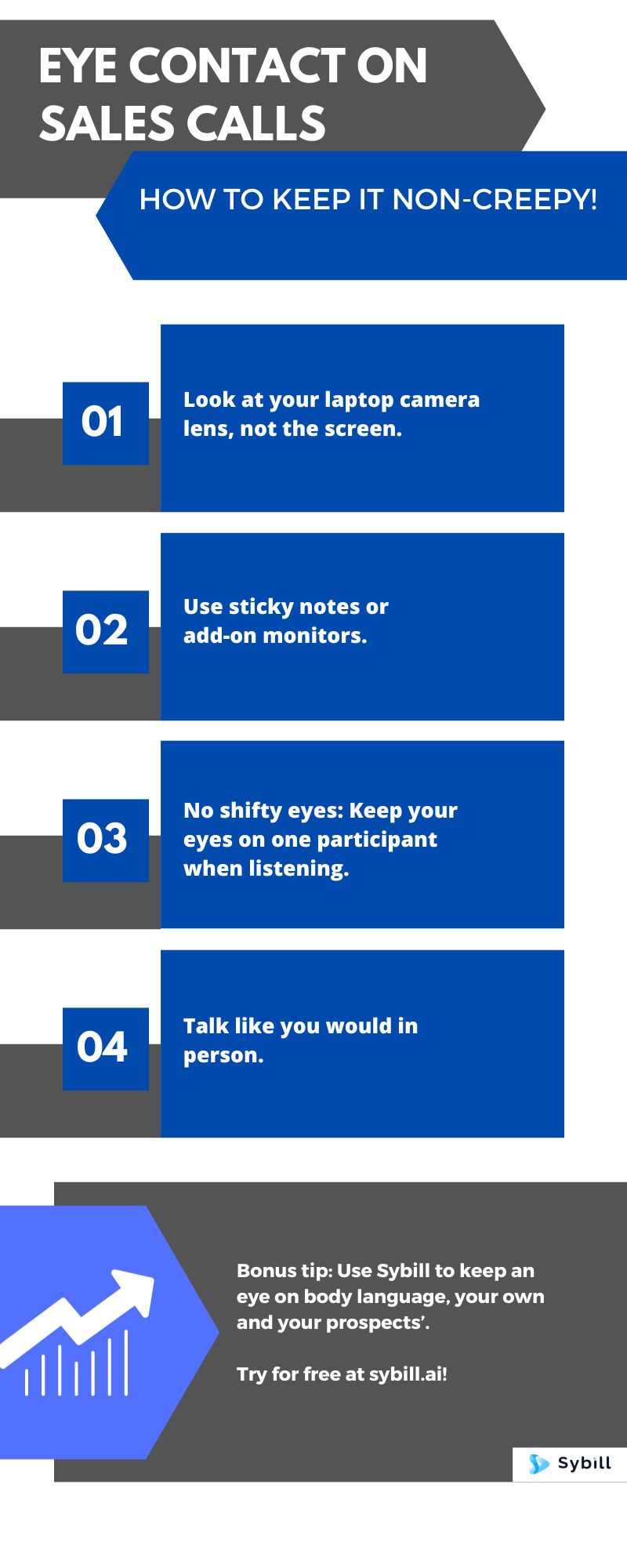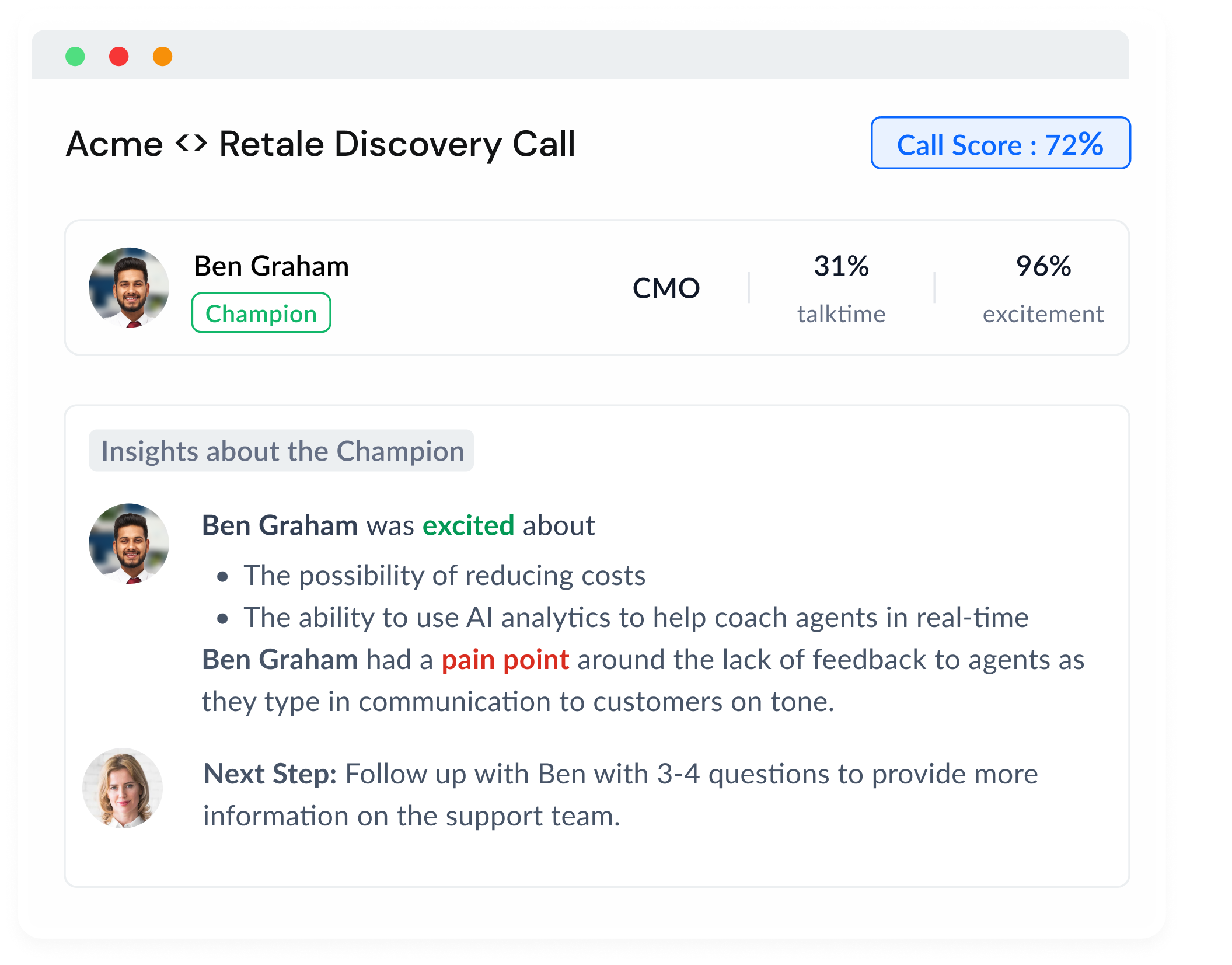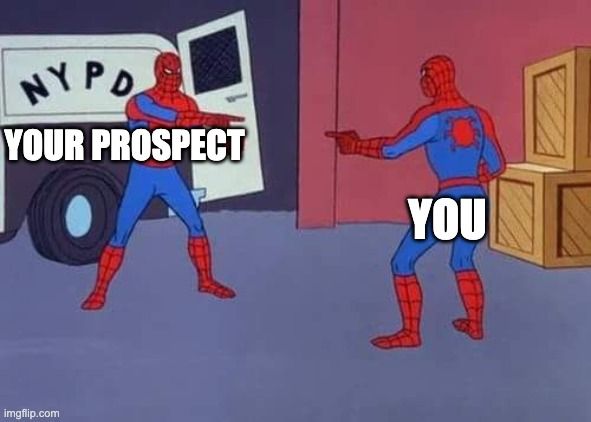7-38-55.
No, this is not a random series of numbers.
It's a breakdown of what matters the most when interacting with someone.
What is the 7-38-55 rule, exactly? And why does it matter in the world of sales?
This 7-38-55 rule results from behavior psychologist Dr. Albert Mehrabian's extensive research on body language. It finds that in any two-way interaction,
- 7% of the communication is attributed to verbal cues;
- 38% to tonality;
- And a staggering 55% to body language.
Decades later, his research is even more relevant, especially in body language, emotional intelligence, and rapport-building in virtual selling.
Eye contact in sales: What’s so special about it?
Remember the 7-38-55 rule: only 7% of what you say is important. So, it's crucial to pay attention to body language to build trust, rapport, and relationships effectively. Yet, it is challenging when all your prospects see is your face on a screen. Your great posture, your confidence, your firm handshake - none of it matters, leaving little room for body language faux pas.
And that makes creating a connection through your eyes that much more critical (and that much more difficult) on sales calls. The first and most important thing it communicates to your prospect is that you know your stuff and you're not rattling off a script.
It's also a sign of empathy and confidence, both essential indications of emotional intelligence - a critical skill in the sales world. And even more important in the world of virtual sales.
(Eye) Rolling into the Post-Pandemic World of Virtual Selling: Creepy Vs. Comfortable
Communication experts largely agree that maintaining eye contact is becoming more and more important in virtual selling and interactions for sales reps.
According to body language and virtual communication expert Mark Bowden, "If I get strong eye contact and get close proximity with you, and you're in a safe place such as your home, your brain produces a neurochemical called dopamine. It's the neurochemical of positive expectation and optimism." (Mark is also an advisor at Sybill.)
Generating optimism is part of converting a prospect into a buyer. They should be able to trust you and feel positive about your product or service, and what it promises to deliver.
And yet, eye contact gone wrong can be creepy and can make the other person feel uncomfortable. You planned to offer psychological safety but did the exact opposite.
So, how do you ensure your eye movements are positive?
How much eye contact in sales calls is too much?
Is there such a thing as "optimal" eye contact?
At which point does eye contact turn to stare and comfortable flips to creepy?
If you’re a beginner in body language nuances and facial expressions on virtual sales, here’s a pro tip:
- Widened eyes signify curiosity
- Narrow eyes indicate suspicion or worry
- And a quick glance at Sybill’s sales call reviews and reports highlighting these non-verbal cues - both yours and your prospects’ - can save the day.
4 eye contact tips for sales: How to get it right on video calls

Tip #1 - Position your laptop so you look directly at the lens, not the screen
If the lens of your laptop’s webcam is located on top of the screen, you will be looking down at the prospect. If it’s at the bottom, you would be looking up.
You need to be at eye level with them, just like you would if you were sitting across from each other. Gauging the optimal position may require trial and error, but this extra effort to forge a genuine connection will pay off.
To ensure optimal performance, position your prospect's video screen image in line with your lens. This will help you to avoid breaking eye contact with them, and take care of any distractions.
Remember, your prospect needs to see you and vice-versa clearly, and that shared energy will contribute towards acing your sales conversations.
Tip #2 - Consider strategically placed add-on monitors or sticky notes
If you have to refer to notes or slide decks, use a second monitor positioned next to the device you are using for the sales pitch or demo. If not possible, put sticky notes on your screen to read without needing to look elsewhere.
Tip #3 – Focus your eyes on any one participant on the video call
Focus on one person as you look into the lens. For online meetings, avoid looking around too much as it may make you appear distracted. In person, it's better to scan the room while talking.
Alternatively, when you look squarely at the lens, everyone will feel you are looking at them. Thus, that personal connection will be forged.
Tip #4 - Try to be natural, like you talk in real life
Use your usual sales strategies for a good conversation. Don't focus too much on your eye movements or it may seem robotic. Instead, mirror your prospect's non-verbal cues, and don't overthink it.
If you are generally uncomfortable with social interactions and eye contact makes you anxious, it may not seem natural at first. But you will get there.
Practical Exercises to Improve Eye Contact in Sales Calls
Mastering the art of eye contact in virtual sales takes practice. Here's a collection of exercises designed to help you make genuine connections through your screen:
- Mirror Practice: Stand in front of a mirror and pitch your product. Observe your eye movements and their intensity. It's an effective way to become more self-aware and refine your natural gaze during presentations.
- Record and Review: Set up a mock sales call and record yourself. Play it back, noting moments where you either break eye contact too often or hold it too long. Adjusting based on this feedback can make a world of difference.
- Two-Minute Drill: Engage in a brief conversation with a colleague, maintaining consistent eye contact. Afterwards, exchange feedback on how natural the interaction felt. This helps you identify the sweet spot between too much and too little.
- Follow the Smile: Ask a friend to move around a room. Your task is to keep your gaze on them and start talking only when they smile. This helps sharpen your focus and responsiveness during dynamic interactions.
Remember, the journey to mastering eye contact is a marathon, not a sprint. Practice these exercises regularly, and soon, your eyes will effortlessly weave tales of confidence, empathy, and trust.
What can Sybill do to help?
Every sales call is a matter of preparation and, sometimes, a little stress. You don't need the extra burden of getting flustered over your eye movements and gestures. Nobody needs the chatter of comfortable vs. creepy in their heads when presenting a demo or doing a discovery call.
Sybill helps sales teams build relationships and rapport by improving body language communication with AI-powered coaching and insights. These sales tips are based on real-life video calls and are designed to help you understand your body language strengths and weaknesses, and actively listen to what your prospects’ body language is trying to tell you.
Learn about other tips to dramatically improve your sales calls.
Or sign up here to solve the eye contact conundrum in your sales calls.















.png)





